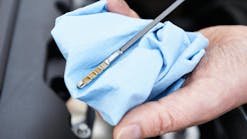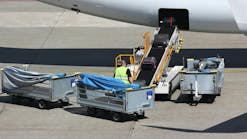WICHITA, Kan. (April 19, 2007) – Hawker Beechcraft Corporation today celebrates the 75th anniversary of Beechcraft. Walter and Olive Ann Beech formed Beech Aircraft Corporation April 19, 1932 at the old Travel Air manufacturing facilities in Wichita, Kan. Events and activities will occur throughout the year, including special Beechcraft celebrations at the Experimental Aircraft Association's annual Air Venture show in July as well as an open house in September in conjunction with the American Bonanza Society Convention at Beech Field in Wichita. Updates on events and activities, as well as history and other information will be released throughout the year and can be found at www.hawkerbeechcraft.com.
"This year we celebrate the 60th anniversary of the venerable Bonanza, the 75th anniversary of Beechcraft and the beginning of our new company, Hawker Beechcraft Corporation. We think Walter and Olive Ann would be very proud," said Jim Schuster, chairman and CEO. "As we celebrate the past, we also look forward to writing the next book in the history of our great company."
Beechcraft began with the classic Model 17 Staggerwing. Designed for the business traveler, the airplane proved to be faster than military pursuit airplanes of the day. During World War II, the company produced the AT-7 and AT-11, derivatives of another classic, the Beechcraft Model 18 and trained almost 90 percent of all U.S. Army Air Corps bombardiers and navigators. Following the war in 1947, the company introduced the Model 35 Bonanza, an airplane whose descendants continue in production today as the Beechcraft Bonanza G36.
From the very beginning, Beechcraft airplanes were modified for military and special-mission use. Quality manufacturing, rugged designs and superior performance met the needs of militaries and governments around the world.
Throughout the years, Beechcraft added and developed product lines into what is today one of the broadest product lines of any manufacturer. Pioneering use of technology, such as composite materials for fuselage construction, has kept the company at the forefront of general aviation manufacturing for 75 years. With over 45,000 aircraft manufactured and over 36,000 still flying, the Beechcraft story is an enduring legacy that is only beginning. Hawker Beechcraft Corporation is taking the best of two of the strongest brands in aviation and growing them into a company writing the next 75 years of history.
Hawker Beechcraft Corporation is the world's leading business, special-mission and trainer aircraft manufacturer – designing, marketing and supporting aviation products and services for businesses, governments and individuals worldwide. The company's headquarters and major facilities are located in Wichita, Kan., with operations in Salina, Kan.; Little Rock, Ark.; and Chester, England, U.K. The company leads the industry with a global network of over 100 factory-owned and authorized service centers.
Hawker Beechcraft History
1930s
• Beech Aircraft Corporation is founded in 1932 by Walter H. and Olive Ann Beech.
• The first Beechcraft produced is the Model 17 — the classic Beechcraft "Staggerwing." Designed especially for the business traveler, the airplane proves to be faster than military pursuit airplanes of the day and wins numerous air races.
• In 1937, Beech introduces the Model 18 "Twin Beech." This airplane is to business what the DC-3 is to the airlines. Produced until 1970, the 33 years of continuous Model 18 production was a record until surpassed by the Beechcraft Bonanza.
1940s
• During World War II, more than 14,000 Beechcrafters produce some 7,400 airplanes for the United States and Allied armed forces. It is estimated that 90 percent of all U.S. Army Air Corps bombardiers and navigators are trained in AT-7 and AT-11 aircraft — derivatives of the Beechcraft Model 18.
• Following the war, in 1947, Beech introduces the Model 35 Beech Bonanza. The new Beech is a high-performance, single-engine, business airplane. Its record for continuous production is still lengthening.
1960s
• In 1961, Beech introduces the Baron B55, the forerunner of today's Baron G58, one of the most popular owner-flown twin-engine aircraft available.
• In 1962, the 125 business jet was first conceived by the DeHavilland Aircraft Company as a purpose-designed jet for personal business travel. It featured a cabin with stand-up headroom throughout its 19-feet 4-inch length and first flew with a Rolls Royce Viper 520 turbojet engine.
• In 1964, Beech introduces the Model 90 Beech King Air. It quickly establishes itself as the industry standard in corporate jetprops. Today, the various King Air models maintain a market share of more than 90 percent in their class.
• In 1968, Beech enters an expanding commuter airline market with the Beechcraft 99 Airliner.
• By 1968, the 125 business jet undergoes several engine changes and other airframe modifications to reflect the latest standards. The DeHavilland Aircraft Company by that time had been bought by the Hawker Siddeley Corporation and the 125 series aircraft became better known simply as the 'Hawker.'
1970s
• In 1971, the Hawker airframe experiences its first big change – a fuselage stretch of two feet. The 600 series featured the 3,750-pound Rolls-Royce Viper 601 turbojet engine, a 25,000-pound takeoff weight and a range of over 1,500 nautical miles.
• In the mid-1970s, the Garrett TFE-731 engine is fitted to the Hawker Series 600 airframe and the Series 700 was born. The aircraft with its new turbofan engines had double the range of the turbojet-powered 600 even though they both had the same fuel capacity.
• In 1974, Beech delivers the first Beech King Air 200, which brings new standards of room, speed, and passenger comfort to a business airplane. Beech has delivered nearly 2,000 Model 200s in civilian and military versions.
• In 1975, Beech delivers the first C-12 - the military version of the Beech Super King Air 200 - to the U.S. Army. Today, all four branches of the U.S. Armed Forces - Army, Navy, Air Force, and Marine Corps - fly C-12s in various configurations. The Navy also uses Beech T-34C jetprop trainers for primary flight training, and versions of the Beech King Air Model 90, designated T-44A, for multi-engine training.
1980s
• On Feb. 8, 1980, Beech Aircraft Corporation becomes a subsidiary of Raytheon Company, a diversified electronics and technology company located in Lexington, Massachusetts.
• Early in 1984, Beech delivers the first of its new pressurized 1900 Airliners to regional airlines. Today, more than 600 of the 19-passenger jetprops have been delivered worldwide.
• Also in 1984, Beech introduces the Beech King Air 300, which offers improvement in speed, performance, and cabin amenities over its predecessors.
• On Dec. 2, 1985, Beech announces the addition of the Beechjet to its product line. Beechjet is a 535-mile-per-hour eight-to-ten passenger transport and features new business jet technology.
• On Feb 15, 1986, a prototype of the new Beech Starship takes its first flight. The Starship is the first all-composite, twin-turbine business aircraft. It featured state-of-the-art avionics, a large swept wing and a forward canard.
• In early 1988, Beech announces it will relocate assembly and subassembly work on the Beechjet from Mitsubishi facilities in Japan to Kansas, creating hundreds of new jobs for American workers.
• In October 1988, Beech introduces the Beechjet 400A, which features a larger interior and the most advanced flight deck available.
• In October 1989, Beech introduces the Beech King Air 350. With a wider wing span, double-club seating and two-foot-high winglets, the 350 is the most comfortable and capable King Air ever built.
• In December 1989, the Beech Starship is certified.
1990s
• In February 1990, U.S. Air Force officials announce the selection of the Beechjet for its T-1A Jayhawk program to train tanker and transport pilots. With all contract options exercised, Beech Aircraft is to provide 180 Beechjets to the Air Force for specialized undergraduate pilot training.
• In September 1990, Beech Aircraft commits to compete for the U.S. Air Force and Navy Joint Primary Aircraft Training System. The Beech team offers a missionized version of the Pilatus PC-9 to be called the Beech MkII, an advanced, high-performance primary trainer.
• In March 1991, Beech is awarded a type certificate for the 1900D Airliner, a state-of-the-art 19-passenger, pressurized aircraft featuring a 71-inch stand-up cabin, more baggage capacity, and improved passenger comfort features.
• At the National Business Aircraft Association convention in October 1991, Beech introduces the new King Air C90B, which features a redesigned passenger cabin, new sound absorbent and moisture resistant interior panels, four-blade propellers, new propeller spinners and a new paint scheme.
• On Jan. 17, 1992, Beech delivers the first T-1A Jayhawk to the U.S. Air Force in ceremonies near the company's jet assembly line.
• In August 1993, Raytheon Company acquires the Corporate Jets business from U.K. Company, British Aerospace, producers of the mid-sized Hawker jet line. It was renamed Raytheon Corporate Jets.
• In mid-September of 1994, Beech Aircraft and Raytheon Corporate Jets merge to form Raytheon Aircraft Company.
• At the end of 1994, U.S. Air Force exercises sixth option for 32 T-1A Jayhawks worth $127 million, bringing the total order to 180 aircraft worth $755 million.
• In April of 1995, the company's new Administration Building opens. A $10 million, 100,000-square-foot facility, the building provides a modern showcase in which to conduct business with Raytheon Aircraft customers from around the world.
• On June 22, 1995, the Beech MkII is chosen as the U.S. Air Force and U.S. Navy's next-generation primary trainer aircraft in a highly competitive selection process. The multibillion-dollar program calls for the production of more than 700 aircraft. The joint services would soon name the aircraft the T-6A Texan II.
• In September 1995, Raytheon Aircraft introduces its all-new light jet, the Raytheon Premier I, which utilizes the latest technologies in design and construction to provide outstanding comfort, performance, and value.
• Also in September 1995, the first Hawker 800XP (Extended Performance) is delivered to a customer. The Hawker 800XP represents the first upgrade of the Hawker line since its acquisition by Raytheon Company.
• In April 1996, the 3,000th Beech Bonanza A36 rolls off the production line. The 5,000th King Air is delivered in June 1996.
• Raytheon Aircraft introduces the company's all-new, super mid-sized jet, the Hawker Horizon, during the National Business Aircraft Association convention in November 1996.
• In June 1997, Raytheon Aircraft announces the formation of Raytheon Travel Air, an aircraft fractional ownership company featuring the Hawker 800XP, the Beechjet 400A, and the King Air B200.
• In spring of 1997, the company marks 50 years of continuous production of the popular single-engine Bonanza series.
• In the summer of 1997, the company delivers the 180th and final T-1 Jayhawk pilot trainer to the U.S. Air Force.
• In July 1998, the first production T-6A Texan II makes its maiden flight. Four other production aircraft would join the first to conduct flight tests in preparation for first delivery in 1999.
• On Dec. 22, 1998 - exactly 53 years to the day from the first flight of the famed Beech Bonanza - the new Raytheon Premier I takes to the skies for the first time. The new entry-level business jet flew a successful 62-minute debut, paving the way for certification efforts in 1999.
• The new Raytheon Premier I entry-level business jet completes more than 700 flight hours toward certification, and validates all critical performance numbers.
2000s
• On March 23, 2001, the future of business aviation arrives. Raytheon Aircraft celebrates the Federal Aviation Administration certification of the new Premier I business jet. The Premier I is the first certified business jet with a composite fuselage, the first clean-sheet business jet certified by Raytheon Aircraft, and the first new airplane certified by Raytheon Aircraft in more than a decade.
• In an April 17, 2001, ceremony Raytheon Aircraft officially rolls out the second of its composite fuselage business jets. The super mid-size Hawker Horizon has transcontinental range and seating for up to 13.
• On May 30, 2001, James E. Schuster is named Chairman and CEO of Raytheon Aircraft.
• On June 22, 2001, the innovative Premier I achieved an important milestone when first delivery was enthusiastically received by Troy Eaden.
• On Aug. 11, 2001, the new super mid-size business jet, the Hawker Horizon, conducts its maiden flight. The composite-fuselage jet flew a 2 ½-hour mission from Wichita's Beech Field that tested the aircraft’s flying qualities, engine operation, low-speed handling and climb performance. The aircraft flew to 10,500 feet and operated at speeds up to 225 knots.
• At NBAA 2002, Raytheon Aircraft announced the return of the Hawker and Beechcraft brands. Both known worldwide for their high performance, reliability, and large, comfortable cabins the brands represent corporate-flown aircraft (Hawkers) and those certified for single-pilot flight (Beechcraft).
• On May 6, 2003, Raytheon Aircraft introduces the Hawker 400XP at the 2003 European Business Aviation Conference and Exhibition. This new Hawker is a critical step in the company's overall strategy to create distinct branding references for our customers. The aircraft was formerly known as the Beechjet 400A.
• On Oct. 7, 2003, Raytheon Aircraft introduces the Collins Pro Line 21 avionics suites for the Beechcraft King Air 350 and B200. The cockpit upgrades mark a long line of product enhancements for the King Air line, which will celebrate its 40th anniversary in 2004.
• On Jan. 20, 2004, Raytheon Aircraft celebrates the 40th anniversary of the first flight of the Beechcraft King Air. The original Beechcraft King Air Model 90 lifted off from Beech Field in Wichita on this date, and flew on to become most successful business aircraft of all time. The King Air family today remains a highly versatile aircraft line.
• On May 25, 2004, the 100th Premier I is delivered to a business in Virginia, marking the beginning of a long production run for the speedy and roomy business jet.
• On July 27, 2004, Raytheon Aircraft Company announces a fully integrated glass cockpit with Garmin G1000 avionics into the Beechcraft Bonanza and Beechcraft Baron, adding even more quality and value to these legendary single and twin piston aircraft models. New paint schemes and logos are announced in April 2005, and the aircraft are formally renamed to Beechcraft Bonanza G36 and the Beechcraft Baron G58.
• The Hellenic Air Force uses T-6A's from its 45-strong fleet to conduct air patrols, protecting the skies over the 2004 Summer Olympics held in Greece.
• On Dec. 23, 2004, the FAA grants the Hawker Horizon a provisional type certificate following more than 1800 hours of developmental and certification flight. The Hawker Horizon, which utilizes the latest in composite technology and construction techniques, enters the market with the best overall performance in its class and long range capabilities of 3,400 nautical miles.
• On Jan. 18, 2005, the T-6B upgraded primary training aircraft began the first leg of its world tour. The tour included flight demonstrations in Europe, the Middle East and Asia on display at the Air Show Down Under in Avalon, Australia and the Paris Air Show in France.
• On Jan. 24, 2005, the 6,000th Beechcraft King Air is delivered with the same quality and performance that has been built into every Beechcraft product since 1932. Over 40 years, more than 20 versions of commercial and special mission King Airs have been produced.
• On March 8, 2005, the 300th T-6A primary trainer is delivered to the U.S. Air Force, marking substantial progress on the Joint Primary Aircraft Training System program contract that calls for the delivery of 800 aircraft through 2017.
• On March 16, 2005, Raytheon Aircraft Company reaches a tentative agreement with NetJets, to purchase up to 50 Hawker Horizons for its expanding fractional market fleet, confirming the quality and performance of the most technically-advanced super-midsize business jet on the market.
• On May 18, 2005, at EBACE, the Hawker 800XPi, an improved version of the Hawker 800XP, that features avionics upgrades, a new cabin management system, and a standard 5-year warranty on the airframe, engines, and avionics, is unveiled at the European show. The new Premier IA is also announced and features a totally redesigned interior, avionics enhancements, as well as several other system improvements, further evolving the industry-leading Premier I.
• On June 13, 2005, during the Paris Air Show, Raytheon Aircraft Company announced the Beechcraft King Air 350ER, an extended range special mission aircraft that provides a one-company solution by combining expertise from two of Raytheon’s other businesses, Space & Airborne Systems and Technical Services Company.
• On July 25th, at Oshkosh, Raytheon Aircraft Company unveiled the new Beechcraft King Air C90GT, an evolution of the popular Beechcraft King Air C90B. The upgraded Beechcraft King Air C90GT delivers a 25-knot increase in max cruise speed and up to 50 percent reductions in the time needed to reach optimum cruise altitude.
• On Aug. 9, 2005, Hainan Airlines became the first Raytheon Aircraft Authorized Service Center in mainland China.
• On Sept. 20, 2005, the National Aeronautics Association presented an official speed record for the Beechcraft Premier I at the National Championship Air Races and Air Show in Reno, Nev.
• On Oct. 22, 2005 Raytheon Aircraft Company certified the new Beechcraft Premier IA. Featuring a redesigned interior, upgraded avionics, and a 5-year warranty, the composite fuselage aircraft is the largest, single-pilot jet in the world.
• On Nov. 3, 2005 Raytheon Aircraft Company announced certification of the Beechcraft Bonanza G36, with the first fully integrated avionics system in a piston-engine aircraft. Proven, year after year, the airplane’s solid, unmistakable feel combined with the Garmin G1000 avionics system and GFC 700 autopilot, provides incredible safety and situational awareness.
• On Nov. 8, 2005 at NBAA, Raytheon Aircraft Company introduced the Hawker 850XP, the newest aircraft in the Hawker family, utilizing winglets designed by RAC. The aircraft is an evolution of the highly successful Hawker 800XPi.
• On Nov. 8, 2005, Raytheon Aircraft Company announced that its super-midsize Horizon business jet would transition to the Hawker family nomenclature as the Hawker 4000.
• On Nov. 17, 2005, Raytheon Aircraft Company was honored as the 2005 Association of Fundraising Professionals Greater Wichita Outstanding Corporation during the Philanthropy Day Awards ceremony. AFP's annual awards recognize individuals and organizations whose achievements have made a significant impact on society, nationally and internationally.
• On Dec. 2, 2005, NetJets, Inc. signed a contract for the purchase of 50 Hawker 4000 super-midsize aircraft for their global fractional fleet. Combined with a 10-year guaranteed maintenance program, the total value of the contracts exceeds $1 billion, making it the largest single commercial order in the history of Raytheon Aircraft Company. Deliveries are to commence in 2007 and continue through 2013.
• On Dec. 15, 2005, Raytheon Aircraft Company announced certification of the Beechcraft Baron G58, the first piston-twin with a fully integrated avionics system.
• On Dec. 15, 2005, the T-1A Advanced Military Trainer aircraft reached the one million flight hour mark with the U.S. Government.
• On Dec. 20, 2005, Raytheon Aircraft Company obtained certification for the King Air C90GT. The upgraded King Air added new PT6A-135 Pratt & Whitney engines increasing the airplane's max cruise by 26 knots, reduced the time to reach its certified ceiling by 50 percent and decreased take off distances.
• On Jan. 12, 2006, Raytheon Aircraft Company was awarded a $1.1 Billion supply chain contract from the U.S. Air Force for the Joint Primary Aircraft Training System (JPATS).
• On March 2, 2006, the mid-size Hawker 850XP, the next generation in a continuing line of successful Hawker 800-series aircraft with RAC-developed winglets, achieved certification.
• On April 4, 2006, Raytheon Aircraft Company delivered the 300th T-6A primary trainer to the U.S. military.
• On June 1, 2006, Raytheon Aircraft Company completed function and reliability testing on the Hawker 4000 super-midsize aircraft.
• On July 18, 2006, Raytheon Aircraft Company unveiled the Beechcraft AT-6 Joint Airborne Weapons System, a multi-mission, multi-role version of the highly successful T-6A/B designed for the surveillance, reconnaissance, close air support, global war on terrorism, homeland security and training operations for the twenty-first century.
• On Oct. 3, 2006, at a ceremony in Little Rock, Ark., Raytheon Aircraft Company broke ground on a $16.3-million, 112,000-square-foot facility expansion to support completions of the Hawker 4000. A new 54,000-square-foot hangar bay is part of the expansion as well as extensions of back portions of existing buildings to provide additional woodshop, upholstery, sheet metal and storage space.
• On Oct. 16, 2006, Raytheon Aircraft Company announces the introduction of two new Hawker models, the Hawker 900XP and Hawker 750. RAC also delivers the 500th King Air 350 in a special ceremony at the NBAA Convention.
• On Oct. 25, 2006, at a ceremony in Little Rock, RAC delivers the 800th Hawker 800 to America's Collectible Network.
• On Oct. 27, 2006, Raytheon Aircraft Company announces an NBAA order tally for 112 aircraft worth nearly $1 billion.
• On Nov. 21, 2006, the Hawker 4000 is certified. The most advanced super-midsize jet in the world today; it has the features of a much larger airplane in a super-midsize body with technology that leads the industry in almost every respect. With an intelligent balance of speed, range and payload, through advanced integrated systems and a composite fuselage, the Hawker 4000 is truly a breakthrough aircraft.
• On March 26, 2007, Raytheon Aircraft Company became Hawker Beechcraft Corporation, a company formed by GS Capital Partners, and Onex Partners, beginning the next great chapter of two of aviation’s most enduring brands.




